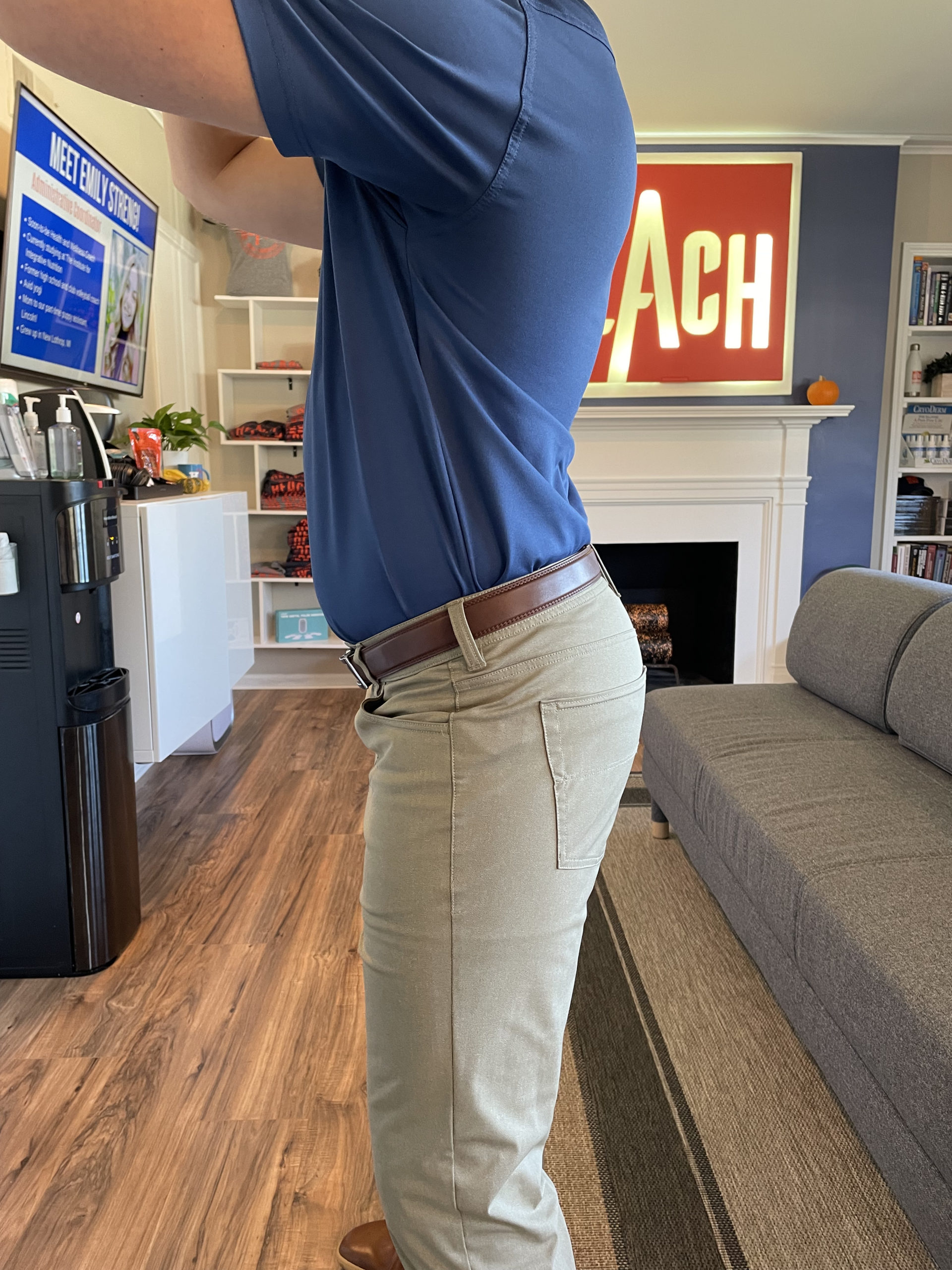Does it look like you are deliberately sticking out your posterior when you walk or stand? If so, you might have an anterior pelvic tilt. A pelvic tilt can compromise your posture and affect your range of motion. Fortunately, this issue doesn’t have to be a lifelong problem.
Would you like to know how to fix anterior pelvic tilt? You are in the right place! We are about to share simple exercises for correcting the issue. Before delving into that, let’s clarify what an anterior pelvic tilt is and how to self-diagnose it.
What Is Anterior Pelvic Tilt?
An anterior pelvic tilt occurs when your lower spine curves inward and your posterior juts outward. From the side, a person with an anterior pelvis will have a banana shape with their gut sticking out and their backside pointing the other way.
**Note, anterior pelvic tilt is not a disease, it’s an observed postural position. And it does not necessarily have to correlate with back pain!
The spinal position places unnecessary strain on your spine, leading to tension and pain in your lower back muscles. If you don’t get treatment, the problem may also impede your range of motion.
An anterior pelvis may be due to poor core strength and stability, lack of exercise, and excessive sitting in a hunched position. You can combat the condition by being conscious about standing in a “stacked,” upright position. You can also engage in corrective strengthening and stretching exercises that support stomach muscles and correct anterior pelvic tilt.
How to Tell If You Have Anterior Pelvic Tilt
Two simple ways to self-diagnose an anterior pelvis are checking your posture in the mirror and examining your back muscles. The mirror examination involves checking your reflection from the side. If your chest, gut, and lower back are jutting forward and your backside poking backward in an exaggerated manner, you may have an anterior pelvis.
Alternatively, rub your fingers against your lower back. If the muscles in the right and left sides of your lower back feel like vertical steel pipes separated by a ravine, you may have an anterior pelvis.
The Thomas Test is an easy test to execute which identifies tight hip flexors, often associated with anterior pelvic tilt. It involves laying back on a flat and elevated surface, e.g., a bed. Your knees should be hanging off without your feet touching the ground. Slowly raise one knee to your chest and drop it before doing the same with the other leg.
If your resting leg stays down and against the surface while you raise the other knee, your pelvic alignment is fine. However, if you can’t raise a knee to your chest without rotating your hip or straightening/raising the resting leg, you may have a tilted pelvis.
Do you live near Plymouth, MI, and suspect that you have an anterior pelvis? Are you looking for a chiropractor in Plymouth, MI, who can help? Contact us to schedule an exam!
How to Correct Anterior Pelvic Tilt
The first step in correcting an anterior pelvic tilt is finding your ideal pelvis position. An optimally positioned pelvis will lead to less strain in your lower back muscles.
Find your ideal pelvic position by bending over like you are in a golfing stance. Slowly move your hips forward and backward with your hands on your lower back. When you feel the muscles in your lower back soften, that’s your ideal or neutral position.
Stand up straight and try to maintain the neutral hip position. If you can’t, follow these steps to practice better control of neutral pelvis:
- Lay face down on a comfortable surface, e.g., an exercise mat, carpet.
- Slowly pelvic tilt (think “tucking your tail” or “plumber butt”) to flatten out your backside.
- Hold the position and bend the knee of one leg, slowly moving the heel to your backside without arching the back (this helps you feel how your leg movement influences your pelvic position).
- Put down the lifted leg and repeat the motion with the other leg.
- Focus on breathing from your abdomen during the exercise, and avoid arching your back or lifting the hip of the active leg toward the ceiling; otherwise, you won’t feel how bending the knee wants to pull you into anterior pelvic tilt.
- Watch the video above to get a visual representation of this exercise.
Other exercises that can help correct an anterior pelvis include:
- Squats
- Glute bridge
- Birddog
- Plank
- Active pelvic tilting
- Dying bug
But the above exercises are all predicated on doing the exercises correctly in an ideal neutral pelvic position.
Southeast Michigan Chiropractor | REACH Rehab + Chiropractic Center
That’s a great start to knowing how to fix anterior pelvic tilt. However, you don’t have to overcome the issue on your own. If you are in or around the Plymouth area, visit our chiropractic rehab center for professional assistance.
At REACH Rehab + Chiropractic, we provide five-star chiropractic services that treat the symptoms and causes of an anterior pelvis. You can count on our specialists for nonsurgical care with lasting results that help you feel better.
Are you ready to fix your anterior pelvic tilt? Contact our friendly team at REACH Rehab at (734) 530-9134 or book here.



